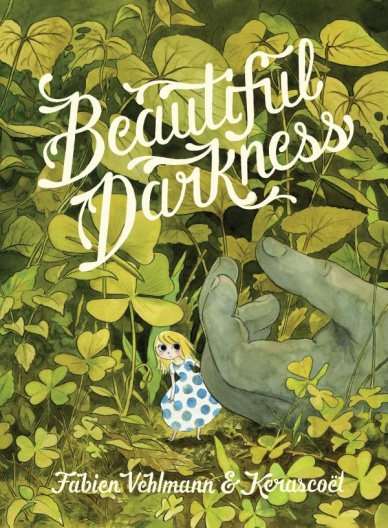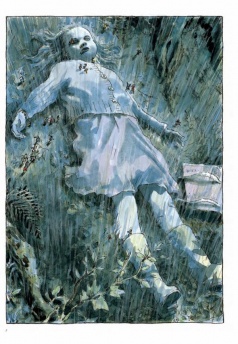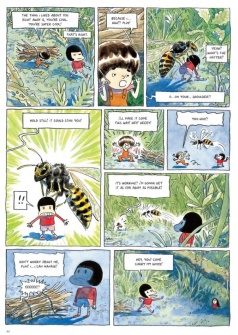
In a new (rebooted) weekly feature, we hope to spotlight graphic novels more often. This week, we take a look at Drawn and Quarterly’s “Beautiful Darkness,” by Fabien Vehlmann and Kerascoet.
While it’s often ill advised to make large-scale generalizations, it is perhaps not too off the cuff to assume that many of us, myself included, were raised on fables and fairy tales. They were a staple to many childhoods, and they served a very specific purpose.
In some cases, these tales would help to acclimate us to the notions of storytelling. Through the terrific and unbelievable adventures through many unlikely heroes, we would be taken to a different place, one that is impossibly different from our own and where many of us find we’d rather stay. It develops the imagination and allows for an escape, and overtime it engenders a love for fantasy in all of us that takes different forms — whether you love comics, films, television, books or any other form of entertainment. A belief in the unreal is fostered, and we embrace it in different ways.
The flip side to this, though, is that we learn things we may not have expected to learn in the first place. The stories we were told as children, in their original incarnations, served as teaching devices and warnings to the same extent that they represented a fantasy. In fact, many of the original iterations of these stories are quite disturbing and dark, the modern day versions of which represent a very pale imitation of, and exploring these stories and their cultural impact later in life often reveals a skewed appreciation of cultural values.

It’s this that brings us to “Beautiful Darkness.” Based on an idea by Marie Pommepuy and written by Fabein Vehlmann, the recently released graphic novel from Drawn and Quarterly translated by Helge Dascher is a magnificently haunting experience. The book stars the young girl Aurora who, along with a group of tiny thumb-sized people, live inside the dead body of a girl whose body lays dormant in the woods. It’s at both a charming and incredible graphic novel as well as a truly horrifying and disturbing read, and its this eponymous nature of the story that makes “Beautiful Darkness” one of the most important new releases of the year.
In this book, Vehlmann has put together quite the little story. The book somewhat fluctuates between a happy go lucky and care free tale and something a bit more, and it’s none more apparent than the opening few pages. The sequence introdues our lead heroine Aurora and essentially explains the world that she comes from, that of a people that can live inside the dead body of a normal, human-sized girl, but it’s done with such playfulness that the horror doesn’t even settle in right away. The way through which the characters speak to one another, their concerns and problems throughout never seem to quite touch on the larger issues at stake; even when something much bigger and darker is directly in front of them, the characters are often too focused on whimsy and childlike humor. It’s almost like their entire reality is done out of focus; they’re the Smurfs or Fraggles living in a dystopic village that also houses the Overlook Hotel.
It’s that madness that hides in the corners of the pages that makes the book really interesting. See, since the characters don’t comprehend their behavior, their actions are all the more biting. In this story, the characters find themselves in a parable of almost Orwellian heights, transposed onto a more medieval hierarchy and structure. It’s at times a harsh critique of high society and at other times a simpler Swift-esque satire, thumbing its nose with a wink and nudge in order to hide the barbs hidden behind its back. There’s even a good deal of “Lord of the Flies” stuck in the book as well, because in many ways the book seeks to capture the ways that civilization devolves within an isolated environment through the eyes of those we would perceive as innocent, much in the way that William Golding did in his famous novel.
What’s amazing, though, is that the book never tips the scale; it never leans too far in either direction, it remains largely even-keeled throughout, which is what makes the end result so fascinating. And the moral ambiguity that remains throughout the entire book becomes one of its most interesting facets, with a haunting finale that encapsulates many of the books running ideas in a few unsubtle pages of transformation.
Continued below
What truly makes the book remarkable is the wonderfully visceral and emotive artwork by Kerascoet, the pen name of Parisian artists Marie Pommepuy and Sébastien Cosset. The watercolors used in the book at times represent strikingly polar opposite elements of the story being told. On the one hand, the characters of Aurora or Hector or Plim have a cartoonish child-like quality that we underestimate. The characters seem to embody so many innocent aspects and qualities that it’s often difficulty to comprehend the gravity that relates to their actions. It’s that duality that then makes the book so engrossing. It’s like reading a comic by Bill Watterson where Hobbes murdered Calvin; of course the tiger would eat the boy, but the tiger is so cute, isn’t he?
These intriguing and complex characters offset many aspects of the story that ultimately become the most resonant. “Beautiful Darkness” finds itself slowly descending further and further into rather dark territory, and the fact that the characters don’t seem to be cognizant of this influences the narrative in truly visible ways. Characters that are marked for death seem to be blissfully unaware what these life-changing events mean, and the weight and gravitas of scenes is often played down. Yet the horror that ensues is never something that is lost on the reader, as Kerascoet’s hauntingly evocative artwork delivers a character-fueled story like none other.
In contrast to these characters, though, the setting of the book more often than not does match the solemnity of the situations. In fact, the frequent reminder that the book takes place in and around the dead body of a young girl is perhaps one of the most difficult aspects of the narrative to cope with. There lays with the girl a certain amount of subtext and clues as to how she got there, but the decomposition of the body remains an important recurring element to the story that is only exacerbated as the story continues. So while the characters themselves seem to sort of revel in the magic of their situation and strikingly duplicitous behavior that governs their society, Kerascoet never shies away from reminding us just what the book implicitly revolves around. These characters have no problem with the dead body of a girl in the woods, but it is hard for the reader not to have quite a few problems with it as time goes on.
Still, the general environment in which these characters live is just generally incredible. Kerascoet’s use of watercolor is impeccable throughout, creating lush landscapes and at points rather crushing splash pages. It often contrasts well with the characters of the books, in that they essentially resemble cartoons within a realistic landscape. There are a few scenes in the book that will perhaps stay with readers more than others, and it’s hard to not just sit and explore every leaf and blade of grass that Kerascoet have so beautifully rendered within the pages of the book.

Of course, it’s the collaboration between Vehlmann and and Kerascoet that makes the book work, rather than the individual parts. There are many moments throughout that clearly play on the strengths of all the storytellers involved. In fact, many pages read as if they could be single page stories, pint-sized moments in time delivered as part of a serialized McCay-styled sunday strip instead of a graphic novel. There is only one true story throughout the book, but there are at times many moving pieces and spinning plates, all of which find various conclusions at different times, and this interesting mixture of pace and storytelling alongside structure and placement is what makes the collaboration between Vehlmann and Kerascoet so palpable throughout.
Suffice it to say, “Beautiful Darkness” is a very compelling and impactful graphic novel. There exists around the book a certain amount of hype, for certain, but it’s hype that decidedly pays off rather well. The adventures of Aurora and her so-called friends is a memorable one, and it very much recalls the kind of fairy tales and stories we were told when we were younger, just closer to the source material. “Beautiful Darkness” certainly skewers towards an older audience, and in this book lies a certain cautionary tale as well as a scathing indictment of societal trends and behaviors, but it’s hard not to see aspects of it that couldn’t appeal to a younger audience if given the correct amount of context.
“Beautiful Darkness” is sweet, scary, humorous and humbling, and it’s certainly one of the year’s best graphic novels.
“Beautiful Darkness” is on sale now. You can read a preview of it here.






